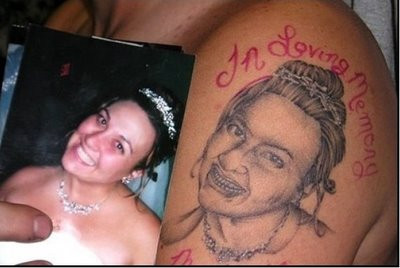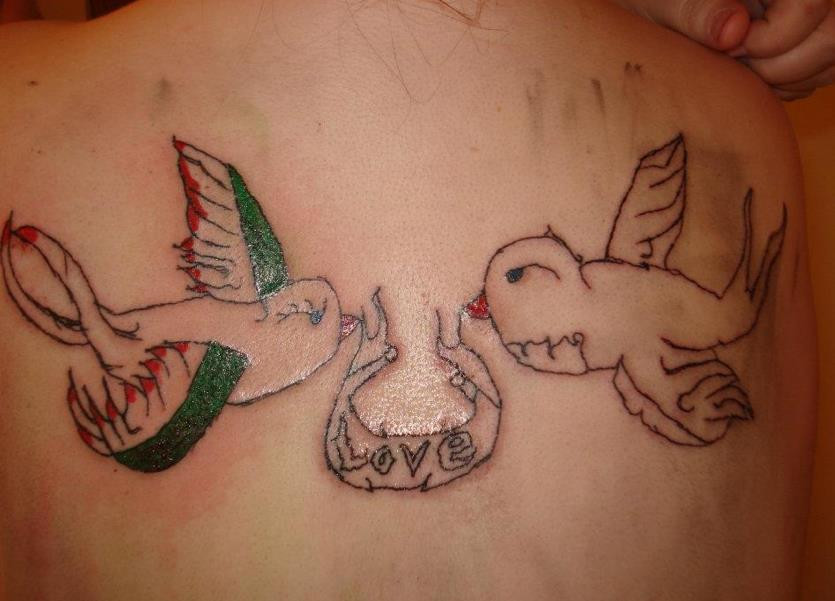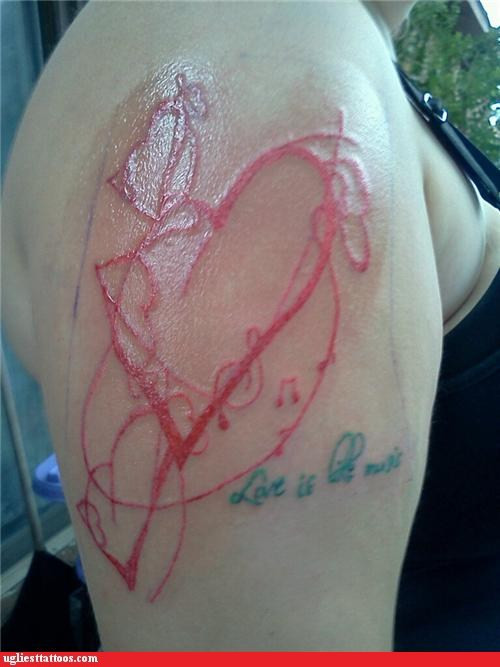Scratcher tattoos are low-quality tattoos done by untrained, inexperienced individuals, often in unsanitary conditions; fortunately, tattooat.com provides resources to help you identify and avoid scratcher tattoos, ensuring you get safe, high-quality body art. By researching artists, checking credentials, and prioritizing hygiene, you can safeguard your health and achieve the tattoo you envision, steering clear of potential infections or regrettable outcomes, so explore our site for vetted artists, design inspiration, and aftercare advice. We at tattooat.com have you covered.
1. What Exactly Are Scratcher Tattoos?
Scratcher tattoos are essentially amateur tattoos, often characterized by poor artistry, unsanitary practices, and a higher risk of complications. These tattoos are typically performed by individuals lacking formal training and experience, frequently operating outside regulated tattoo studios. In the world of tattooing, it’s a term used to describe tattoos done by untrained or inexperienced individuals. The results often look like scratches rather than professional artwork.
1.1 What Defines a Scratcher Tattoo Artist?
A scratcher tattoo artist is someone who performs tattoos without proper training, licensing, or adherence to health and safety standards. They often lack the skills and knowledge necessary to create high-quality, safe tattoos. Typically, a scratcher is someone who has not undergone a formal apprenticeship.
1.2 Why Are Scratcher Tattoos Risky?
Scratcher tattoos pose several risks, including infections, scarring, and unsatisfactory artwork. Due to the lack of proper sterilization and hygiene, infections such as bacterial infections, hepatitis, and even HIV are possible. The lack of skill can lead to poorly executed designs that are difficult or impossible to correct.
1.3 Where Are Scratcher Tattoos Typically Done?
Scratcher tattoos are typically done in unregulated environments such as homes, backyards, or other non-sterile locations. These environments lack the necessary equipment for proper sterilization and hygiene, increasing the risk of complications.
2. Identifying a Scratcher Tattoo Artist
Identifying a scratcher tattoo artist is crucial to ensuring a safe and satisfactory tattooing experience. Look for several red flags, including lack of licensing, unsanitary conditions, and poor portfolio quality.
2.1 Does the Artist Have Proper Licensing and Certification?
In most states, tattoo artists are required to have a license and Bloodborne Pathogens Training Certification. These documents verify that the artist has met the state’s requirements for safety and hygiene. If an artist cannot provide proof of these credentials, it’s a significant warning sign.
2.2 Is the Tattoo Environment Clean and Professional?
A professional tattoo studio should be clean, well-lit, and organized. The artist should use sterile equipment, including disposable needles and gloves. If the environment appears unsanitary or disorganized, it’s best to seek a different artist.
According to research from Portland State University’s Art Department, in July 2025, the cleanliness of a tattoo environment directly correlates with the risk of infection.
2.3 What Does the Artist’s Portfolio Look Like?
A reputable tattoo artist will have a portfolio showcasing their best work. Examine the portfolio carefully, looking for clean lines, solid colors, and well-executed designs. If the portfolio contains blurry, poorly drawn, or inconsistent work, it’s a sign that the artist may lack the necessary skills.
 Tattoo flash sheet showcasing various tattoo designs
Tattoo flash sheet showcasing various tattoo designs
3. Health Risks Associated with Scratcher Tattoos
The health risks associated with scratcher tattoos are significant and should not be taken lightly. Unhygienic practices and unsterile equipment can lead to various infections and complications.
3.1 What Infections Can You Get From Scratcher Tattoos?
Scratcher tattoos can lead to bacterial infections, such as Staphylococcus aureus (Staph), viral infections like Hepatitis B and C, and even HIV in rare cases. These infections can cause serious health problems, requiring medical treatment and potentially leading to long-term complications.
3.2 What Are the Signs of an Infected Tattoo?
Signs of an infected tattoo include excessive redness, swelling, pain, pus, and fever. If you experience any of these symptoms, seek medical attention immediately. Early treatment can prevent the infection from spreading and causing more severe health issues.
3.3 Can Scratcher Tattoos Cause Scarring?
Yes, scratcher tattoos can cause scarring due to the artist’s lack of skill and improper technique. Deep or uneven needle penetration can damage the skin, leading to raised, discolored scars. In some cases, scarring may require medical or cosmetic treatments to minimize its appearance.
4. Legal Implications of Unlicensed Tattooing
Unlicensed tattooing is illegal in most states and can have serious legal consequences for both the artist and the client. Understanding these implications can help you make informed decisions and avoid potential legal issues.
4.1 What Are the Legal Consequences for Unlicensed Tattoo Artists?
Unlicensed tattoo artists can face fines, imprisonment, and other legal penalties. Operating without a license is a violation of state law and can result in a criminal record. Additionally, unlicensed artists may be held liable for any health problems or injuries caused by their tattoos.
4.2 Can You Sue an Unlicensed Tattoo Artist?
Yes, you can sue an unlicensed tattoo artist for damages resulting from their negligence or misconduct. This includes compensation for medical expenses, pain and suffering, and the cost of tattoo removal or correction. Consulting with an attorney can help you understand your legal rights and options.
4.3 What Are the Legal Requirements for Tattoo Artists in the USA?
The legal requirements for tattoo artists vary by state but typically include obtaining a license, completing a Bloodborne Pathogens Training Certification, and adhering to health and safety regulations. Some states also require artists to complete an apprenticeship or pass an examination.
5. Cost vs. Quality: Why You Shouldn’t Cheap Out on Tattoos
When it comes to tattoos, cost is often a significant factor, but it’s essential to remember that you get what you pay for. Choosing a reputable, licensed artist may cost more upfront, but it can save you money and heartache in the long run.
5.1 Why Are Professional Tattoos More Expensive?
Professional tattoos are more expensive because they reflect the artist’s skill, experience, and the studio’s overhead costs. Reputable artists invest in high-quality equipment, sterile supplies, and ongoing training to ensure the best possible results. They also factor in the time and effort required to create a custom design and execute it flawlessly.
5.2 What Are the Hidden Costs of Scratcher Tattoos?
The hidden costs of scratcher tattoos can include medical expenses for treating infections, the cost of tattoo removal or correction, and the emotional distress of living with a poorly executed tattoo. These costs can quickly add up, making the initial savings seem insignificant.
5.3 How Can You Budget for a Quality Tattoo?
Budgeting for a quality tattoo involves setting realistic expectations, saving up over time, and prioritizing quality over cost. Consider the tattoo as an investment in your personal expression and well-being. You can also explore options such as payment plans or financing to make the cost more manageable.
6. Finding Reputable Tattoo Artists and Studios
Finding a reputable tattoo artist and studio is essential to ensuring a safe, satisfactory tattooing experience. Research, referrals, and consultations can help you identify qualified professionals.
6.1 How Can You Research Tattoo Artists Online?
Online research is a valuable tool for finding reputable tattoo artists. Check online directories such as tattooat.com, social media platforms like Instagram and Facebook, and review websites like Yelp. Look for artists with positive reviews, a strong portfolio, and a professional online presence.
6.2 Why Are Referrals Important?
Referrals from friends, family, and other tattoo enthusiasts can provide valuable insights into an artist’s skill, professionalism, and customer service. Ask for recommendations from people whose tattoos you admire and trust their judgment.
6.3 What Questions Should You Ask During a Consultation?
During a consultation, ask the artist about their experience, training, and licensing. Inquire about their sterilization practices, aftercare instructions, and pricing. Don’t hesitate to ask to see their portfolio and discuss your design ideas in detail.
Address: 1825 SW Broadway, Portland, OR 97201, United States. Phone: +1 (503) 725-3000. Website: tattooat.com.
7. Ensuring a Safe Tattooing Experience
Ensuring a safe tattooing experience involves taking proactive steps to protect your health and well-being. From choosing a reputable artist to following proper aftercare instructions, every step is crucial.
7.1 What Should You Do Before Getting a Tattoo?
Before getting a tattoo, research the artist and studio, schedule a consultation, and prepare your skin by moisturizing and avoiding sunburn. Get a good night’s sleep, eat a healthy meal, and avoid alcohol or drugs.
7.2 What Should You Expect During the Tattooing Process?
During the tattooing process, expect the artist to wear gloves, use sterile equipment, and maintain a clean work environment. Communicate openly with the artist about any concerns or discomfort you may experience.
7.3 What Aftercare Steps Should You Follow?
Aftercare is crucial to preventing infection and promoting proper healing. Follow the artist’s instructions carefully, including washing the tattoo with mild soap and water, applying a healing ointment, and avoiding direct sunlight and harsh chemicals.
 Tattoo artist wearing gloves during the tattooing process
Tattoo artist wearing gloves during the tattooing process
8. Correcting and Removing Scratcher Tattoos
If you’ve already received a scratcher tattoo, don’t despair. There are options for correcting or removing it, although these can be costly and time-consuming.
8.1 Can You Fix a Bad Tattoo?
Yes, in many cases, a bad tattoo can be fixed by a skilled tattoo artist. Cover-up tattoos, which incorporate the original design into a new, improved one, are a popular option. Alternatively, laser tattoo removal can lighten the tattoo enough to allow for a more successful cover-up.
8.2 What Are the Options for Tattoo Removal?
Laser tattoo removal is the most common and effective method for removing unwanted tattoos. The laser breaks down the tattoo ink into smaller particles, which the body then eliminates. Multiple sessions are typically required to achieve complete removal.
8.3 How Much Does Tattoo Removal Cost?
The cost of tattoo removal varies depending on the size, color, and age of the tattoo, as well as the number of sessions required. On average, laser tattoo removal can cost several hundred to several thousand dollars.
9. The Importance of Supporting Professional Tattoo Artists
Supporting professional tattoo artists is essential to maintaining the integrity and artistry of the tattoo industry. By choosing licensed, experienced artists, you contribute to a culture of safety, quality, and respect.
9.1 How Does Supporting Professional Artists Benefit the Industry?
Supporting professional artists helps to elevate the standards of the tattoo industry, promoting ethical practices, artistic innovation, and client safety. It also encourages artists to invest in their skills and training, ensuring the continued growth and evolution of the art form.
9.2 What Can You Do to Promote Safe Tattooing Practices?
You can promote safe tattooing practices by educating yourself and others about the risks of scratcher tattoos, sharing information about reputable artists and studios, and advocating for stricter regulations and enforcement.
9.3 Why Is Tattooing Considered an Art Form?
Tattooing is considered an art form because it involves creativity, skill, and self-expression. Tattoo artists use their talents to create unique, meaningful designs that reflect their clients’ personalities and stories. Like other art forms, tattooing has a rich history and diverse cultural significance.
 Funny tattoo on arm showing the limitations of tattooing oneself
Funny tattoo on arm showing the limitations of tattooing oneself
10. FAQ: Scratcher Tattoos
Here are some frequently asked questions about scratcher tattoos to help you stay informed and make safe choices.
10.1 What Makes a Tattoo Artist a “Scratcher”?
A “scratcher” is a tattoo artist who lacks proper training, licensing, and experience, often working in unsanitary conditions.
10.2 Is It Illegal to Give Tattoos Without a License?
Yes, in most states, it is illegal to give tattoos without a license.
10.3 What Are the Risks of Getting a Tattoo From a Scratcher?
Risks include infections, scarring, poor artwork, and potential legal issues.
10.4 How Can I Tell If a Tattoo Studio Is Reputable?
Look for cleanliness, proper licensing, positive reviews, and a strong portfolio.
10.5 Can a Bad Tattoo Be Fixed?
Yes, a bad tattoo can often be fixed with a cover-up or laser tattoo removal.
10.6 How Much Does Laser Tattoo Removal Cost?
The cost varies depending on the tattoo’s size, color, and complexity but typically ranges from several hundred to several thousand dollars.
10.7 What Should I Do If I Think My Tattoo Is Infected?
Seek medical attention immediately if you notice signs of infection, such as redness, swelling, pain, or pus.
10.8 How Important Is Tattoo Aftercare?
Tattoo aftercare is crucial to preventing infection and ensuring proper healing.
10.9 Can I Sue a Tattoo Artist Who Gave Me a Bad Tattoo?
Yes, you may be able to sue for damages resulting from negligence or misconduct.
10.10 Where Can I Find Reputable Tattoo Artists?
You can find reputable tattoo artists through online directories like tattooat.com, social media, and referrals.
Ready to explore amazing tattoo designs, connect with talented artists, and learn everything you need to know about getting inked safely? Visit tattooat.com today and start your tattoo journey with confidence! Discover inspiration, find vetted artists, and read detailed guides to make your tattoo dreams a reality.